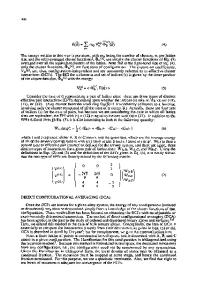Atomistic Modeling Of Ternary And Quaternary Ordered Intermetallic Alloys
- PDF / 904,312 Bytes
- 8 Pages / 612 x 792 pts (letter) Page_size
- 80 Downloads / 433 Views
Atomistic Modeling Of Ternary And Quaternary Ordered Intermetallic Alloys Guillermo Bozzolo1, Joseph Khalil2, Matthew Bartow2, Ronald D. Noebe2 1 Ohio Aerospace Institute, 22800 Cedar Point Road, Cleveland, OH 44142. 2 National Aeronautics and Space Administration, Glenn Research Center, Cleveland, OH 44135. ABSTRACT The structure of ternary and quaternary NiAl-based ordered intermetallic alloys is studied using the BFS method for alloys. A simple calculational procedure, based on the determination of the energetics of local environments surrounding defect atoms is introduced and applied to the study of the defect structure and phase formation in NiAl-based systems. The procedure is illustrated with two different examples: 1) the phase structure of Ni-Al-Fe alloys, focusing on the concentration dependence of the site preference behavior of Fe in NiAl, and 2) the precipitation of a β’ phase in NiAl(Ti,Hf) alloys, focusing on the role of Hf in lowering the solubility limit of Ti in NiAl, thus enhancing the precipitation of a Heusler Ni2Al(Ti,Hf) phase. INTRODUCTION The availability of computationally efficient and physically sound quantum approximate methods allows for the analysis of multicomponent systems at the atomic level. This in turn increases our knowledge-base and understanding of the structure of materials that is currently limited by the inherent difficulties in obtaining such detailed information from experimental studies. The Bozzolo-Ferrante-Smith (BFS) method for alloys [1] is free of many of the constraints, such as the number or type of elements considered, the crystal structure, or the presence of multiple phases, that have limited the use of other theoretical techniques to the application of problems concerning ternary or higher order intermetallic alloys. In this paper we apply the BFS method to the energetic analysis of 3- and 4- element systems with the goal of gaining a better understanding of the interaction between multiple alloying additions and their influence on the microstructure of NiAl-based alloys. This work is meant to complement recent experimental efforts [2,3] and to begin to provide detailed explanations for observed results. THE BFS METHOD The BFS method [1] is based on the concept that the energy of formation of a given atomic configuration is the superposition of the individual atomic contributions ∆H = Σ εi. Each contribution εi is the sum of two terms: a strain energy εiS, computed in the actual lattice as if every neighbor of the atom i was of the same atomic species i, and a chemical energy, εiC, computed as if every neighbor of the atom i was in an equilibrium lattice site of a crystal of species i, but retaining their actual chemical identity. The computation of εiS, using Equivalent Crystal Theory (ECT) [4], involves three pure element properties for atoms of species i: cohesive energy, lattice parameter and bulk modulus. We rely on calculations using the linearmuffin tin orbital method in the atomic sphere approximation (LMTO-ASA) [5,6] for the determination of these par
Data Loading...











